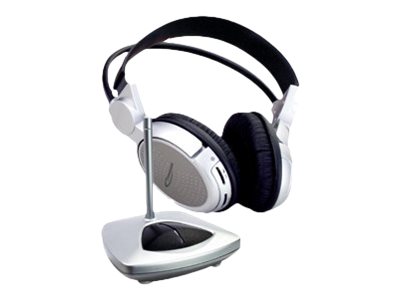
Complete technical specifications, details, expert ratings and review of Typhoon Wireless Audio Headset. Find out how your chosen headphones stack up against the competition and whether they are the ones that best meet your expectations with the headphone comparison feature.
design and dimensions sound quality battery and charging wireless link connections others
| DESIGN AND DIMENSIONS Typhoon Wireless Audio Headset |
|---|
| Product Type | Headphones - 2.4 GHz - wireless | |
|---|---|---|
| Recommended Use | TV, home audio, portable electronics | |
| Bluetooth Range (Operating Distance) | 30 m | Better than 63 % of headphones rated. |
The Typhoon Wireless Audio Headset are wireless headphones. The wireless connection allows absolute freedom of movement and with that increases the comfort of using the headphones. This feature is very popular, especially when using headphones every day. The limiting factor of wireless headphones is a certain delay in the sound transmission between the source and the headphones (almost indistinguishable for a normal user), as well as the need to charge them (in the case of wired headphones, the headphones are recharged by connecting the cable itself). The transmission range offered is up to 30 m. The maximum range represents the maximum distance from the audio transmission source that the headphones can be used for wireless audio transmission. However, the maximum communication range can be affected by obstacles such as people, walls, etc.
The design of the headphones is around the ears. Because of this design, the headphone envelops the entire ear and isolates the ear better from surrounding noise when listening compared to for example on-ear headphones. With that, they offer high-quality listening without interference. However, they are most likely heavier by design and less practical for frequent carrying.
| SOUND QUALITY Typhoon Wireless Audio Headset |
|---|
| Headphones Form Factor | Full size | |
|---|---|---|
| Connectivity Technology | Wireless | |
| Wireless Technology | 2.4 GHz radio frequency | |
| Sound Output Mode | Stereo | |
| Frequency Response | 25 - 20000 Hz | Worse than 82 % of headphones rated. |
| Total Harmonic Distortion (THD) | 0.1% | Better than 95 % of headphones rated. |
| Impedance | 24 Ohm | |
| Diaphragm | 40 mm | Better than 75 % of headphones rated. |
| Dynamic Range | 85 dB | |
| Signal-To-Noise Ratio | 80 dB |
The sound quality can be affected by many factors. When it comes to frequency range, the wider it is, the more detail you will hear when listening. However, the range a person can perceive is highly individual. The average person is able to perceive frequencies in the range of 16 to 20 000 Hz. So the most common frequency range you will see on the market is 20 to 20,000 Hz. Lower frequencies up to approximately 256 Hz are considered bass frequencies. Therefore, the lower the bottom value is, the better the headphones will reproduce bass. Conversely, values from approximately 2 048 Hz upwards are treble. That is why headphones with a high upper value will provide a much more accurate reproduction of high notes. Typhoon Wireless Audio Headset offers a frequency range of 25 - 20000 Hz.
The device connected to the headphones also plays a role most times. The lower impedance value (approximately 100 to 150 Ohms) is suitable for playback from mobile phones, laptops or other portable players that do not have a powerful enough amplifier. The lower impedance will ensure that the required volume level is achieved with less power, thus extending the life of the player. However, at the same time, with lower impedance, there is more distortion of the sound. Headphones with a higher impedance of around 250 Ohms and above are then more suitable for playback from really powerful signal sources or using a headphone amplifier, otherwise the sound coming out of them might not be loud enough. At the same time, higher-impedance headphones will also ensure less distortion in the sound. In the case of these headphones, the impedance reaches the 24 Ohm value.
An important part of these headphones is the diaphragm, which, simply put, converts the electrical signal into a sound. The thin diaphragm that is around 6 mm thick can react quickly to changes in the audio signal and improves high-frequency listening. However, it is less sensitive to bass. The medium-thick diaphragm of around 10 mm provides a fairly balanced sound profile, allowing you to enjoy both bass and treble. A thicker diaphragm of around 20 mm cannot react so quickly to changes in the sound signal, thus impairing bass listening. However, it is more sensitive to higher frequencies. This model features the 40 mm. Total Harmonic Distortion of these headphones is Audio Output | Total Harmonic Distortion. The value quoted by the manufacturer is usually the average distortion over all reproducible frequency bands. This is not a crucial parameter to decide on when making a decision, but on the other hand, keep in mind that higher harmonic distortion can negatively affect sound quality.
| BATTERY AND CHARGING Typhoon Wireless Audio Headset |
|---|
| Battery Type | Headphone battery rechargeable - Nickel Cadmium | |
|---|---|---|
| Power Device | Power adapter - external | |
| Voltage Required | AC 230V |
| WIRELESS LINK Typhoon Wireless Audio Headset |
|---|
| Transmission Range | 30 m | Better than 57 % of headphones rated. |
|---|---|---|
| Radio Channel Qty | 8 | |
| Radio Frequency Range | 2.4 - 2.4835GHz |
| CONNECTIONS Typhoon Wireless Audio Headset |
|---|
| Connector Type |
Headphones (mini-phone stereo 3.5 mm) DC power input |
|---|
| OTHERS Typhoon Wireless Audio Headset |
|---|
| Included Accessories | Wireless transmitter |
|---|
Similar Headphones
Other Typhoon Headphones